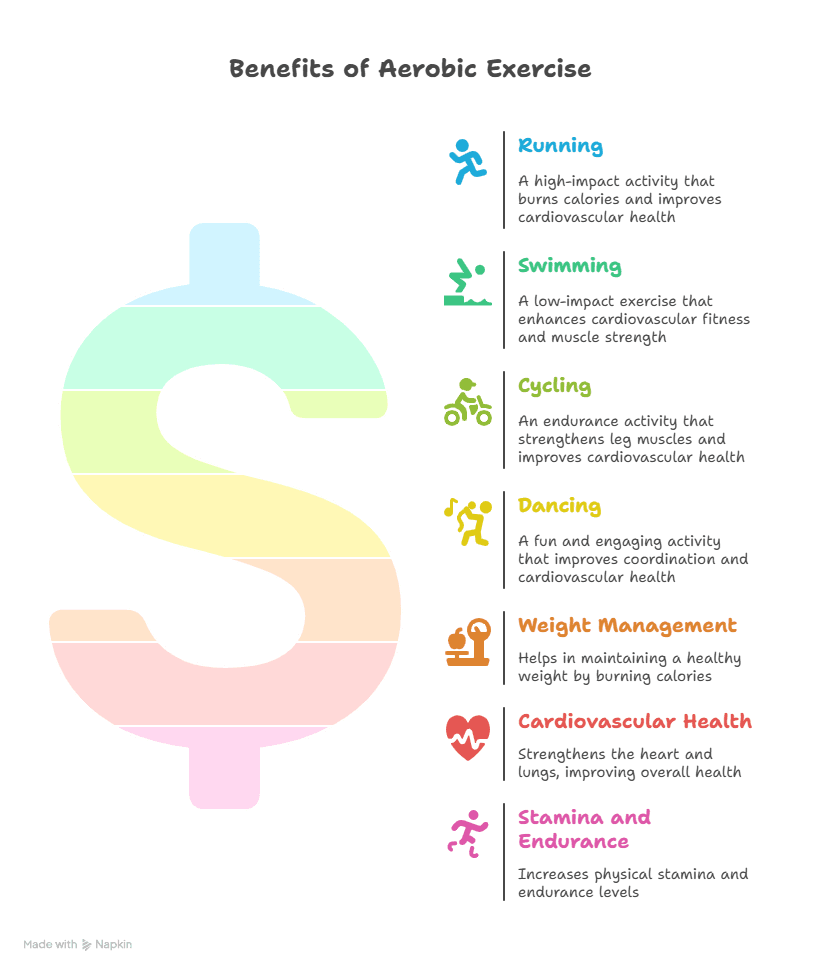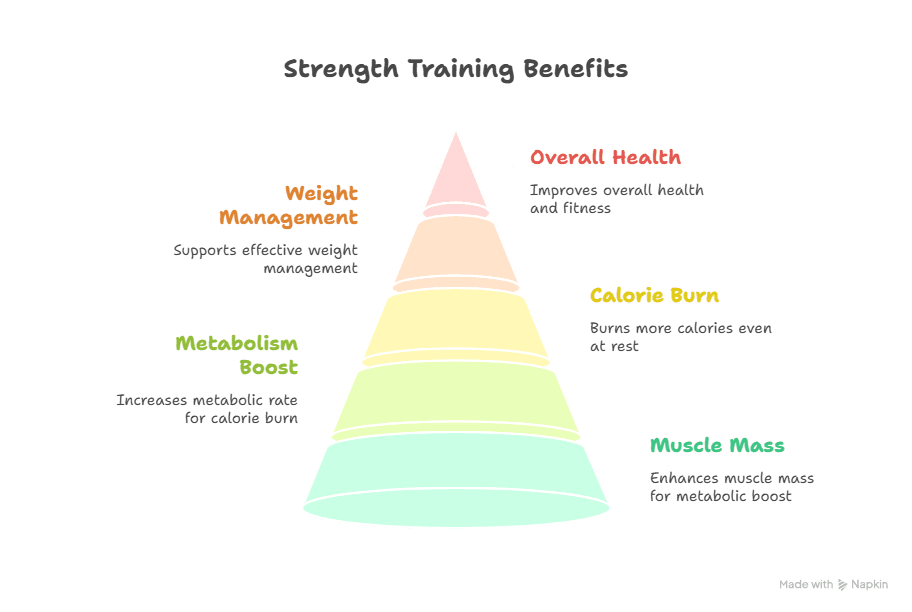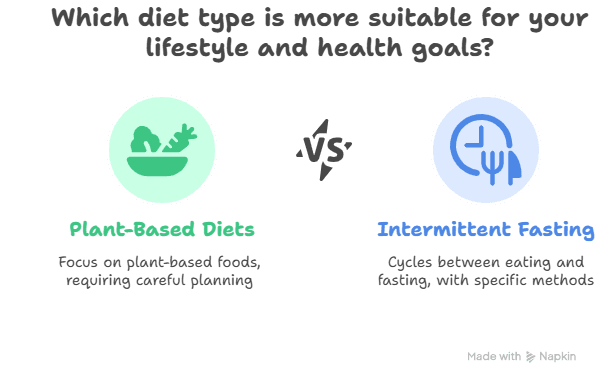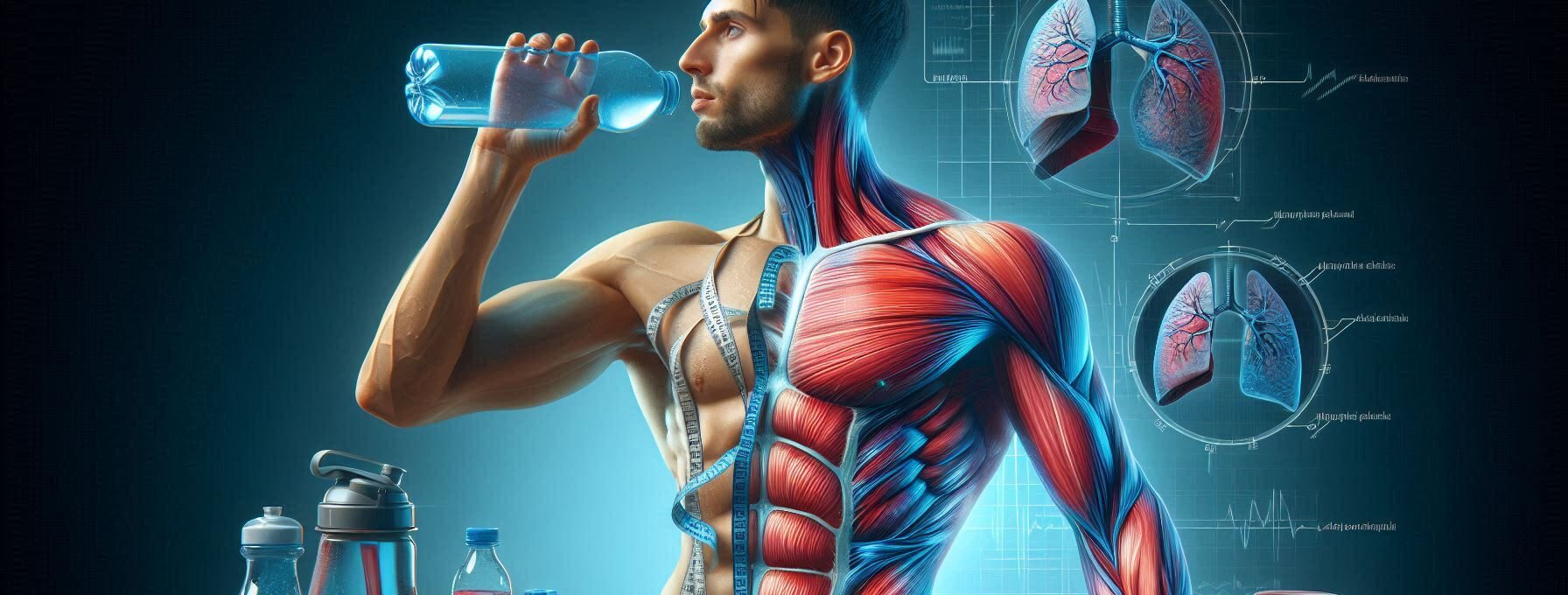Please Note: This post may contain affiliate links. If you click one of them, we may receive a commission at no extra cost to you. As an Amazon Associate, I earn from qualifying purchases.
A lot of people assume that dieting is the only method to lose weight when they want to lose weight. But here's a little secret: strength training might be your best friend on your trip! You know, the kind where you lift weights, sweat a little, and maybe even grunt like a champ? Yes, that's the stuff! It not only helps you grow muscle, but it also speeds up your metabolism and keeps burning calories even after you leave the gym. So, get your dumbbells (or simply some canned beans from your kitchen) and let's talk about why strength training is so important for keeping your weight in check.
Top Takeaways and Key Concepts
Prioritize strength training: Lift weights or do bodyweight exercises to build muscle and boost metabolism.
Combine cardio and resistance: Pair cardio with strength training for optimal calorie burn and long-term weight control.
Eat nutrient-dense foods: Consume protein, fruits, vegetables, and hydration to support muscle recovery and energy.
Track progress and celebrate wins: Log workouts, measurements, and non-scale achievements to stay motivated.
Start gradually and stay consistent: Focus on major muscle groups, progress slowly, and allow rest days.
Summary of This Article
This article emphasizes strength training as a key strategy for weight management, highlighting how building muscle increases resting metabolism and burns calories even after workouts. Combining strength training with cardio enhances fat loss and improves functional fitness, balance, and confidence. Nutrition—particularly protein, fruits, vegetables, and hydration—supports muscle recovery and overall health. Tracking progress, celebrating victories, and starting gradually while remaining consistent ensures long-term success. Strength training is framed as a holistic approach to fitness that improves both physical performance and psychological well-being.
Why Muscle Matters More Than You Think

Muscle burns more calories at rest than a couch potato watching their favorite show—so if you're looking to lose weight, consider lifting weights instead of just lifting the remote!
“I’m on the patch right now. It’s like a nicotine patch but for food.” — Oprah Winfrey
First off, let’s talk about muscles. We often associate them with bodybuilders or superheroes—think Thor with his hammer—but muscles are actually vital for everyone. When you have more muscle mass, your body burns more calories at rest. Yes, you heard that right! It’s like having a furnace inside you that never turns off. According to studies, each pound of muscle burns approximately six calories per day just sitting there looking fabulous. So if you’re trying to manage your weight effectively, building muscle should be high on your list.
Now here’s something else to consider: as we age, we naturally lose muscle mass—a process called sarcopenia (don’t worry; I had to Google that too). This sneaky little phenomenon usually starts in our 30s and can lead to a loss of about 3-5% of muscle mass per decade. Yikes! So, what does this mean for us regular folks? Well, as our muscles dwindle away like socks in the dryer, our metabolism takes a hit too. Think of it as your body’s way of saying, “Hey, remember those fries you loved? Yeah, they’re sticking around a bit longer now.”
Surprising Facts About Muscle and Weight Loss
– Muscle Burns Calories: For every pound of muscle you gain, you can burn about 50 extra calories a day—making it your body’s very own calorie-burning furnace!
– Sassy Sarcoplasm: The more muscle you have, the more sarcoplasm (the jelly-like substance in muscle cells) you accumulate. Think of it as your muscles’ way of getting a little extra cushion for their pushing!
– Metabolism Magic: A higher muscle mass can boost your metabolism even while you sleep. So technically, napping could be considered a workout if you're muscular enough!
– The Protein Party: Eating protein after strength training helps build muscle faster—so treat yourself to that post-workout steak or protein shake; it's basically an invitation to the gains party.
– Muscles vs. Fat: Muscle is denser than fat, meaning it takes up less space. You might weigh the same but look smaller—like magic! Who knew being “heavy” could actually make you lighter on the eyes?
– Age is Just a Number: As we age, we naturally lose muscle mass—but don’t worry! Strength training can help reclaim those lost muscles and keep you feeling youthful (and maybe even able to lift that awkwardly heavy grocery bag).
But fear not! By incorporating strength training into our routine now, we can preserve and even increase our muscle mass. And let’s be real—who wouldn’t want to strut around feeling like a superhero? Not only will you look great in those jeans (yes, the ones you’ve been eyeing), but you’ll also feel stronger and more energetic in your daily life. Imagine lifting your grocery bags without breaking a sweat or keeping up with your kids during playtime instead of sitting on the sidelines gasping for air.
Interestingly enough, strength training isn’t just about bulking up; it’s also about functional fitness. You know how sometimes bending down to pick up that dropped remote feels like an Olympic event? Well, building muscle helps improve your overall strength and balance, making everyday tasks easier. Plus, it reduces the risk of injuries—because who wants to end up on crutches after an ill-fated attempt at reaching for the last cookie on the top shelf?

And let's take a minute to talk about confidence. Seeing progress, like being able to lift larger weights or just not getting as tired after climbing stairs, makes you feel better about yourself like nothing else. Seeing those small wins can change how you think about yourself, both physically and psychologically, in a way that seems almost magical. You start to think that if you can lift those weights at the gym, maybe other problems outside of it won't seem so hard either!
So why not now? The sooner we make strength training a part of our lives, the better prepared we'll be for everything that comes our way, whether it's chasing after kids or finally finishing that mountain trip you've been dreaming about. Believe me, once you start and feel those muscles moving again, you'll wonder why you waited so long!
The Metabolism Boost You Didn’t Know You Needed

Eating spicy foods can boost your metabolism temporarily—so if you're trying to burn calories, consider adding some hot sauce to that salad. Just be prepared for a fiery experience!
“Your body is like a car. It needs the right fuel to run efficiently.” — Jennifer Aniston
Speaking of metabolism—let's get back to that magical furnace idea! When you're lifting weights or doing any form of resistance training, your body goes into repair mode afterward. This recovery phase is where all the magic happens! Your body needs energy (a.k.a., calories) to repair those tiny tears in the muscles caused by lifting weights. Interestingly enough, this post-workout calorie burn can last anywhere from 24 to 48 hours depending on how hard you've worked out.
Imagine going about your day knowing that while you're binge-watching your favorite show or napping (who doesn’t love a good nap?), you're still burning extra calories because of yesterday's workout! That sounds pretty sweet if you ask me. Picture this: you’re curled up on the couch, snacks in hand, and instead of feeling guilty about lounging around like a sloth, you can actually smile because your body is still working hard for you. It’s almost like having a personal trainer who whispers motivational quotes while you’re deep into season five of that series everyone has been raving about.
Fun Facts to Rev Up Your Metabolism
– Spicy Secrets: Eating spicy foods can temporarily boost your metabolism by up to 8%! So, next time you’re sweating over a plate of hot wings, just remember—it’s basically a workout!
– Protein Power: Digesting protein burns more calories than carbs or fats. It’s like your body is saying, “Thanks for the steak; I’ll take it from here!”
– The Power Nap: Believe it or not, short naps can help reset your metabolism. Just don’t tell your boss that napping is part of your health plan!
– Cold Showers = Hot Metabolism: Taking cold showers may increase calorie burn as your body works overtime to warm itself up. Who knew chilling out could heat things up?
– Lifting Spirits (and Weights): Strength training not only builds muscle but also gives your metabolism a long-term boost. It's like giving your metabolic rate a permanent promotion!
– Water Works Wonders: Drinking cold water can temporarily speed up metabolism because your body has to expend energy to warm it up—so hydrate away and consider it a refreshing workout!
Let's get into further detail. We start something called “afterburn” or “excess post-exercise oxygen consumption” (EPOC) when we do strength training. Isn't that a fancy word? After a tough workout, such heavy lifting or squats, your body keeps burning calories at a higher rate for a long time after you've set down the weights. So, while you're curled up on the couch with your favorite blanket (which you should definitely think of as part of your training gear), your muscles are busily fixing themselves and getting their energy back. It's like getting compensated for working extra hours without ever leaving the house!
Let's be honest: who wouldn't want their lazy habits to come with built-in ways to burn calories? Picture this: while your pals were working out at the gym, you were learning how to use a remote control and still burning calories. People would certainly raise their eyebrows and laugh, but deep down, they would be jealous!
Also, it's quite fulfilling to know that every rep you did yesterday is helping you burn calories today, even if it feels like all you're doing now is staring at the screen and reaching for popcorn every now and again. This simple mental strategy can help you stick to your fitness routine. It's not only about those sweating workouts at the gym; it's also about how they pay off when life becomes easy.

And here’s another perk: incorporating strength training into your routine can help boost muscle mass over time. More muscle means a higher resting metabolic rate—which is just a fancy way of saying you'll burn more calories even when you're not working out. So those lazy days become less about guilt and more about celebration! You’ve earned them by investing in yourself through exercise.
So next time you're tempted to skip that workout because you'd rather dive into another episode or take a well-deserved nap, remember this: every minute spent building strength isn’t just making you fitter; it's giving future-you permission to lounge guilt-free while reaping the rewards of yesterday's efforts. Now that's what I call winning at life!
Setting Up Your Strength Training Routine

Lifting weights can actually help you burn calories while you sleep—so technically, your dumbbells might be the best bedtime buddies you’ve ever had!
“Strength does not come from physical capacity. It comes from an indomitable will.” — Mahatma Gandhi
So, what's the first step? First things first: don't let ideas of hefty weights and scary gym equipment get you down! Start with something easy. Push-ups and squats are great bodyweight workouts for beginners, and you don't need any special equipment to do them! I've actually seen individuals get inventive with things they have around the house, like backpacks full of books or water jugs.
I suggest starting with two or three sessions a week that focus on your legs, arms, and back. You should also do some cardio for your heart health. It's like making a dinner that is good for your health! You wouldn't want to eat only dessert every day, even if chocolate cake is the tastiest. The same goes for exercise; you don't want to focus on just one part of it. You need to mix things up to keep them interesting and useful!
Quirky Facts to Pump Up Your Strength Training Routine
– Muscle Memory Magic: Your muscles have memory! After a break, they can bounce back faster than you can say “leg day.” So don’t worry if you take a hiatus; your muscles remember the good times!
– Weights vs. Water: Lifting weights burns more calories than lifting snacks. So next time you reach for that bag of chips, consider picking up some dumbbells instead—your body will thank you!
– Rest Days Are Key: Even superheroes need a day off! Rest days are crucial for muscle recovery and growth—so embrace your inner couch potato guilt-free.
– Laughter Is a Workout: Laughing can burn about 50 calories an hour. So, if strength training feels tough, just watch a comedy special and let those giggles count as part of your routine!
– More Muscles, More Calories: Each pound of muscle burns about 6 calories per day at rest. That means building muscle is like having a tiny calorie-burning factory running 24/7 in your body!
– The Power of Progression: If you think you're not making progress, just remember that even the Hulk started small. Embrace the journey; every rep counts toward becoming your best self!
When you first start, focus on those big muscle groups because they burn the most calories and make you stronger overall. Legs? They are basically the engines of your body. Arms? They can aid you with anything from carrying groceries to giving your friends a high-five after a workout. And don't forget about your back; it keeps you standing up and ready to take on the world! So, definitely, let's make sure to take care of these muscles.
For structure, start with three sets of 10 reps for each exercise. This means you'll complete the exercise ten times in a row, take a break, and then do it two more times. This method helps you build endurance and provides your muscles time to adjust without pushing them too hard right away. As you get stronger, it's important to slowly add more weight or reps. It's like leveling up in a video game: at first, it's easy, but as you get better, you have to fight harder bosses (or lift larger weights).

Remember that slow and steady wins the race (and keeps you from getting hurt)! If you rush into lifting big things, you could hurt yourself or get painful muscles, which could keep you from working out for weeks. Believe me, I've learnt this the hard way! Your body can become used to things and get stronger without putting too much stress on it if you take your time.
Adding cardio to your weight training is extremely important. Not only does it improve your heart health, but it also makes your workouts more fun! Cardio keeps your heart pounding and makes you more fit. It can be as simple as taking a brisk walk, riding a bike, or even dancing around your living room like no one is watching (because who doesn't enjoy an impromptu dance party?).
Let's be honest: changing things up keeps boredom away. No one wants their workout to be as boring as watching paint dry! You never know, but trying out different things might keep you interested and motivated. Along the process, you might find that you have a hidden flair for yoga or kickboxing!
So pick up those dumbbells or whatever else you have sitting around that could work as weights and go to work! If you are consistent, patient, and a little creative with how you do both strength training and cardio, you will be well on your way to feeling great and reaching your fitness objectives. Keep in mind that every little thing you do helps you become a healthier person!
Overcoming Common Misconceptions About Strength Training

If you lift weights, your muscles can actually continue to burn calories for up to 48 hours after your workout—making them the ultimate overachievers in the calorie-burning department!
“I'm not trying to be skinny. I'm just trying to be healthy.” — Khloe Kardashian
Now let's talk about some myths about strength training, because really? They need to be broken! Many people think that lifting weights will make women too muscular or bulky, but that's not true! Women often have lower testosterone levels than men, which makes it hard to build a lot of muscle size without special diets or supplements.
Another false belief is that cardio is all you need to lose weight. I mean, we've all seen those very fit people running in the park who seem like they just came out of a fitness magazine. Cardio is undoubtedly good for you, especially for your heart! It gets your heart racing and helps you lose weight like confetti during a parade. But here's the thing: if you only practice cardio to lose weight, it's like attempting to build a home with only one tool; it doesn't offer you the whole image.
Debunking Strength Training Myths with a Smile
– Weights Won't Make You Bulky: Lifting weights won’t turn you into the Hulk overnight! Women have lower testosterone levels, making it much harder to bulk up. Think of it more as sculpting than bulking!
– Cardio Isn’t the Only King: While cardio is great for heart health, strength training can torch calories even after your workout. It’s like having a calorie-burning sidekick that works while you binge-watch your favorite show!
– Age Is Just a Number: It’s never too late to start strength training! In fact, older adults who lift weights can regain muscle mass and strength faster than they can remember where they left their glasses.
– You Don’t Need a Gym: No gym? No problem! Bodyweight exercises are just as effective. Your living room floor can be your new fitness studio—pajamas optional!
– Sweating Isn’t Mandatory: Not sweating buckets doesn’t mean you’re not working hard. Some people sweat like waterfalls; others just glow. Embrace your unique style of perspiration!
– Rest Days Are Part of the Plan: Skipping rest days won't make you stronger; it might lead to burnout instead. Even superheroes take breaks—after all, who wants to fight crime when they're exhausted?
It's easy to imagine that running or biking for miles can help you lose weight when you think about it. And yes, those things do burn calories faster than you can say, “I'll have another slice of pizza,” but they don't always develop muscle. Let me tell you something interesting: the amount of muscle we have is very important for how our bodies handle weight over time. Your body burns more calories when you are at rest if you have more muscle. That means that even while you're binge-watching your favorite program or taking a nap (who doesn't love a nice snooze?), those muscles are still working hard behind the scenes!
When it comes to keeping your weight under control over time, doing both cardio and strength training together works better. Picture this: you're on the treadmill for 30 minutes and feel fantastic about yourself—sweaty but proud! Then, on different days, you lift weights or do bodyweight exercises that work your primary muscle groups. This combination not only speeds up your metabolism, but it also shapes and tones your body in ways that cardio alone can't.
Strength training really damages your muscles a little bit (which sounds scary, right?). But don't worry! Your body heals these tears by making your muscles stronger during times of rest. This process takes a lot of energy, which means you'll burn more calories even after you've completed doing out! So, even though you might feel like a hot mess during the last set of squats, know that you're doing something good for your body that will help you burn a lot of calories later.
And let's talk about how long things last here too. What happens when life gets busy if all you do is run marathons or cycle until your legs feel like jelly? Over time, it may be harder to stick to a fitness plan that seems boring or tiring. But adding strength training to your workouts makes them more exciting and varied! Plus, who wouldn't want to show off their new strength to their friends? “Oh, really? You need help moving that couch? “I've got this!”
To finish things off well—and because I believe in happy endings—doing both cardio and strength training is the secret to long-term weight loss success. Cardio is great for your heart and burns calories rapidly, but strength training builds lean muscle mass and speeds up your metabolism over time. So why pick one when you can have both? After all, diversity is what makes life interesting, and fitness too!
The Importance of Nutrition Alongside Strength Training

Eating a donut after a workout might sound like a terrible idea, but some studies suggest that a sugary treat can actually help replenish glycogen stores faster than healthy foods—proving that sometimes, carbs are just trying to be your friend!
“Your diet is a bank account. Good food choices are good investments.” — Bethenny Frankel
Nutrition is also very important when it comes to managing your weight, so of course we have to talk about it! If you train hard at the gym but then go to pizza parties and ice cream binges every night (guilty), your progress can slow down faster than a turtle on vacation!
After a workout, you should eat lean proteins like chicken breast or lentils. They help your muscles heal and give you the nutrients you need during your exercises. You know how your muscles feel after a hard workout? They're like that friend who just completed a marathon—tired and in need of some serious care. Enter protein, the muscle healing superhero! Chicken breast is a great choice because it has a lot of protein and not a lot of fat. Just think about it: every time you eat, you're not only giving your body energy, but you're also helping those tired muscles get stronger.
Fueling Your Gains: Nutrition Facts That Pack a Punch
– Protein Power: Eating protein after strength training can help you recover faster. Think of it as giving your muscles a delicious “thank you” note for all their hard work!
– Carbs Are Not the Enemy: Carbohydrates are essential for energy! They’re like the friendly neighborhood Spider-Man—always there to save the day when your energy levels dip.
– Hydration is Key: Staying hydrated helps with muscle recovery and performance. Water is your best workout buddy; it never complains and always has your back (or should we say, your biceps)!
– Micronutrients Matter: Vitamins and minerals may be tiny, but they pack a big punch in supporting muscle function. They’re like the secret agents in your nutrition plan—working behind the scenes to keep everything running smoothly!
– Eating Before Bed Isn’t Always Bad: A small protein-rich snack before bed can aid muscle repair overnight. So yes, that midnight Greek yogurt might just be working harder than you are while you sleep!
If you don't like chicken (and I understand; sometimes you just want something else), legumes are here to help! When it comes to protein, beans, lentils, and chickpeas are really strong. And they have their own set of benefits, like a lot of fiber and other nutrients! So, whether you're making a substantial stew or a fast salad with chickpeas, you're giving your body some significant goodness that helps it heal.
But wait, don't forget about fruits and vegetables! To be honest, these lovely gems deserve more love than they usually get. Not only do they look nice on our plates, but they are also full of vitamins and low in calories. You can think of them as candy from nature: sweet, tasty, and good for you! After working out hard enough to feel like you've climbed Everest (or at least a few flights of stairs), eating an apple or banana may be really refreshing. They not only provide you energy by giving you natural sugars, but they also keep you hydrated because they have a lot of water in them.

Adding a lot of fruits and vegetables to your regimen after working exercise will help lower inflammation and speed up healing. For instance, berries are tiny powerhouses full of antioxidants that fight off those annoying free radicals that come up when you work out. And don't forget about leafy greens like spinach or kale. They are full of nutrients that are good for your health and have very few calories.
You might be wondering how to fit all of this into your regular life. Meal prepping can really help you out here! You could spend a Sunday afternoon making grilled chicken breasts and heating vegetables while listening to your favorite song. It's almost the perfect way to multitask. If you have healthy meals ready to go, you won't have to reach for less healthy options when you're hungry after a tough workout.
And speaking of convenience, smoothies are another great method to mix these things together without any effort. Add some spinach and Greek yogurt (hey protein!) to the mix. Add a banana for sweetness and some frozen berries for flavor explosion, and you're done! This tasty treat after working out has everything you need: it's full of nutrients, keeps you hydrated, and tastes great!
So keep in mind that eating a lot of fruits and vegetables coupled with lean proteins is important for both repairing muscles and keeping your energy up all day. You need to give your body what it needs so you can reach your fitness objectives without feeling like you've hit a wall later. Now go out and eat well—you can do this!
Tracking Progress: Celebrate Every Win!
Lastly—and perhaps most importantly—track your progress along the way so that small victories don’t go unnoticed! Whether it's increasing weights lifted during workouts or fitting into clothes more comfortably over time—celebrate those milestones however big or small they may seem!
Celebrate Your Wins: Fun Facts About Tracking Progress
– Small Steps Matter: Did you know that tracking just a 1% improvement each day can lead to a whopping 37 times better performance in a year? It’s like the tortoise winning the race—slow and steady really does win!
– Visual Motivation: Keeping a progress photo diary is like your own personal reality show! You get to watch the “before” and “after” drama unfold, complete with plot twists (and maybe some unexpected snacks).
– Celebrate Non-Scale Victories: Did your jeans fit better this week? That’s worth more than any number on the scale! Think of it as your body giving you a high-five for all your hard work.
– Track Your Mood: Not all wins are about weight loss. Tracking how you feel can reveal that exercise is also boosting your happiness levels. Who knew squats could come with an emotional bonus?
– Rewards Are Key: Set milestones and treat yourself when you hit them—just not with cake every time! Maybe new workout gear or a fun class instead. Because nothing says “I did it!” like looking fabulous while sweating!
You may keep a log of your workouts and measurements every month just for fun. Who doesn't love looking at images of themselves before and after? Plus, sharing your victories in online communities that support you holds you accountable and encourages others to do the same. It turns into one big cheerleading group that cheers each other on toward their fitness goals!
Strength training isn't only about lifting weights; it's about making healthy choices every day that make you feel good about yourself, not simply looking at the numbers on the scale!
Suggested Resources
Strength Training Basics
https://www.healthline.com/nutrition/strength-training-basics
The Benefits of Resistance Training
https://www.webmd.com/fitness-exercise/features/the-benefits-of-resistance-training
Nutrition Tips for Weight Loss
https://www.eatright.org/health/weight-loss
Frequently Asked Questions
How does strength training help with weight management?
Strength training builds muscle, which increases resting metabolism and helps your body burn more calories throughout the day.
Can beginners start strength training without gym equipment?
Yes, beginners can use bodyweight exercises or household items like water jugs or backpacks to build strength effectively.
Does strength training burn calories after the workout ends?
Yes, strength training triggers the afterburn effect, causing your body to burn extra calories for up to 48 hours post-workout.
Should I combine cardio with strength training for better results?
Combining both improves calorie burn, boosts cardiovascular health, and supports long-term weight management.
How important is nutrition for strength training and weight loss?
Balanced nutrition with lean proteins, fruits, vegetables, and hydration supports muscle repair, energy, and overall progress.
How often should I do strength training each week?
Aim for two to three sessions weekly focusing on major muscle groups, with rest days to support recovery and growth.
How can I track progress while strength training?
Logging workouts, taking measurements, and celebrating non-scale victories help maintain motivation and consistency.

Kevin Collier is a dedicated health enthusiast and writer for FatFAQ.com, where he shares his expertise on weight loss and maintaining a healthy lifestyle. With a focus on practical tips and evidence-based strategies, Kevin aims to inspire readers to achieve their health goals through informed choices. His engaging articles cover nutrition, exercise, and holistic wellness, providing valuable resources for anyone looking to improve their well-being. Passionate about helping others transform their lives, Kevin advocates for sustainable habits that promote lasting health and vitality.





